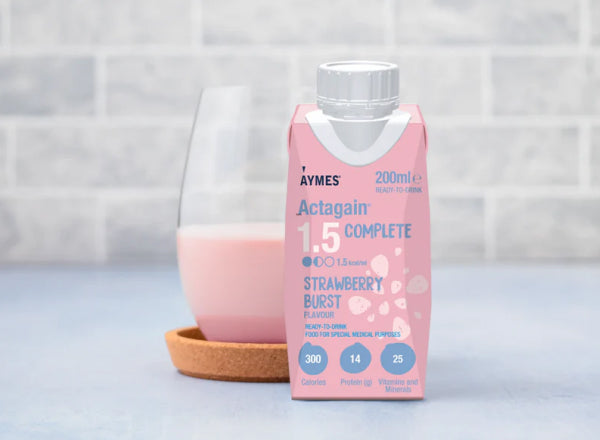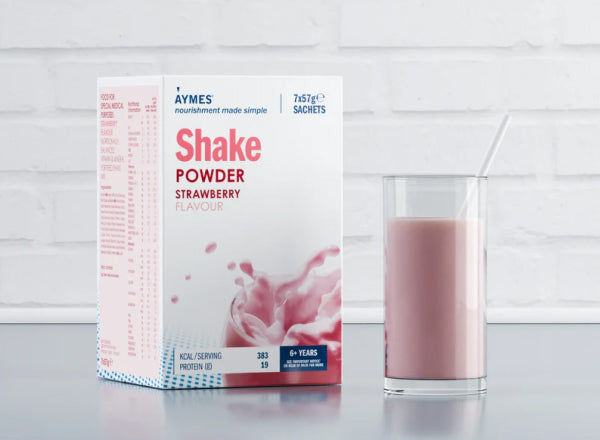
Introduction
There is extensive evidence to show that Oral Nutritional Supplements (ONS) are a clinically and cost-effective way to manage disease-related malnutrition.1,2,3 In adults with, or at risk of malnutrition, clinical benefits are often seen with 300-900kcal/day (e.g., 1-3 ONS servings per day).4
ONS can be used to address malnutrition and improve outcomes amongst patients who are unable to meet their nutritional requirements through an oral diet alone. ONS have proven nutritional, functional and clinical benefits, such as reducing complications and readmissions to hospital and improving hand grip strength and body weight, with little reduction in normal food intake.5
However, ONS are only effective when they are consumed. The volume of ONS served is one important factor which has been found to influence compliance rates. Patient compliance has been described as when “patients consume a high percentage of what is prescribed in order to meet their nutritional requirements and keep wastage to a minimum”.6 This article explores factors affecting patient compliance with ONS and highlights evidence-based strategies to increase compliance, such as offering split doses of ONS.
Factors affecting ONS compliance
ONS compliance rates vary considerably across care settings.6 In a qualitative review of 102 studies, a number of factors were found to affect therapeutic compliance (not specific to ONS compliance).7 These factors were categorised as patient-centered, therapy-related, social and economic, healthcare system, and disease-related factors (see table 1).
Table 1: Factors Affecting Therapeutic Compliance⁷
| Patient-centred | Therapy-related | Healthcare System | Social and Economic | Disease-related |
|
Demographics (e.g. age, ethnicity, gender, marital status) Psychosocial factors (e.g. beliefs, motivation, attitudes)
Health literacy
Physical difficulties
Forgetfulness
|
Treatment complexity Route of administration (e.g. orally versus enterally tube fed)
Side effects
Storage requirements for prescription |
Overall patient experience during appointment Difficulties in getting prescriptions completed
|
Social support
|
Disease symptoms
|
Compliance can also be altered by other factors such as:
- Taste changes and taste fatigue
- Energy density and volume of ONS
- Healthcare Professionals’ (HCPs) perceptions of ONS
The next section will explore these three factors in further detail.
Taste and ONS compliance
It is important to consider taste changes and taste fatigue experienced by patients during disease and associated treatments.
A review of taste and compliance in patients with cancer found that between 36% to 75% of patients receiving chemotherapy report distressing changes in taste, which has been linked to patient compliance with ONS.8 Additionally, loss or change to sense of smell or taste is a common symptom of COVID-19. A recent systematic review and meta-analysis (2020) found that 41% and 38% of patients with COVID-19 infection presented with olfactory (smell) or gustatory (taste) dysfunctions, respectively.9
Sensory attributes of ONS have been found to influence preference and likelihood of ONS compliance. A study in four European countries collected data from 1,771 individuals who were ≥ 50 years and not currently receiving ONS. This was a two-stage, single-blind, randomised, preference study. During stage one, participants received a 5-day trial period during which two bottles of commonly prescribed ONS were administered, with different ONS being consumed each day. In stage two, all participants consumed two bottles daily of one ONS for five days and two bottles daily of a second ONS for a further five days. Taste was found to be a key determinant of the overall opinion of any particular ONS.10
Allowing patients to taste an average of four different types of ONS products before prescription and involving them in the choice of flavours has been associated with a high compliance rate (adherence rate of over 75%).11 Finally, it is worth highlighting that taste fatigue tends to occur when ONS are consumed regularly over a prolonged period.12 In light of the above, discussing the patient’s preferences relating to the taste and flavour of ONS products as well as offering a variety of flavours of ONS may help to manage taste changes and/or prevent taste fatigue.
Energy density and volume of ONS
Clinical benefits of ONS are often seen with 300-900 kcal/day (e.g. 1-3 ONS servings per day).4 For those struggling to take their prescribed ONS, a low volume, high energy ONS product may aid compliance.
A systematic review of 46 studies across a range of settings reported greater compliance with high-energy, low volume ONS (> 2 kcal/ml), compared to standard ONS (1.5-2 kcal/ml).6 Additionally, an observational study of 108 patients showed that high energy, low volume ONS resulted in higher rates of compliance in acutely ill older inpatients.13
Novel high-energy ONS products have become available for once-a-day usage, which provide a clinically effective number of calories (≥300 calories) in one bottle. The idea of a one-a-day dosage is that it allows flexibility in how and when the ONS is taken, particularly since studies have shown that when ONS are taken in small doses, compliance is very high (93%).6
This suggests that the use of high-energy ONS taken in smaller doses may help to improve compliance especially in patients with reduced appetite who may struggle to consume two standard ONS bottles (400 mls) per day (standard clinical practice).6,14
HCP perceptions of ONS
HCPs’ perceptions of ONS play an important role in influencing ONS compliance. A recent survey (2019) of 207 UK Registered Dietitians found that ease of implementation, departmental protocols and professional management pathways were the greatest influences of choice for prescribed ONS products.15
The perception of ONS amongst Allied Healthcare Professionals (AHPs), carers and nursing staff also warrants attention when considering ONS compliance. For example, a review of current treatment options and factors influencing nutritional intake in older people requiring nutrition support found that encouragement from carers and an appropriate ambiance positively influenced ONS compliance for older adults in nursing homes.16 However, while there is widespread appreciation of the benefits of ONS amongst carers, some expressed aversion towards the taste and smell of ONS,17 which could negatively impact patients’ perceptions of ONS.
Strategies to aid ONS compliance
Split doses of ONS
It is important to offer flexible serving sizes for patients struggling with ONS volume or compliance. Evidence has shown that when high energy ONS are taken in smaller doses (62ml), compliance may improve, especially in patients with reduced appetite.14
This randomised controlled trial (RCT) (2015) examined the effects of offering ONS with medication rounds, in varying volumes. A total of 234 malnourished inpatients were randomised into three groups.
- Usual care: offered 125ml of ONS twice a day, between meals
- Intervention 1: offered 125ml ONS twice a day, an hour before meals, together with prescribed medication (if any)
- Intervention 2: offered 62ml ONS four times a day together with prescribed medication (if any).
No differences in compliance were seen between the “usual care” group and “intervention 1” (i.e., there was no difference whether patients received higher volumes of ONS in between meals or during medication rounds). However, more patients consumed their ONS when offered smaller volumes (62ml), four times a day together with prescribed medication.14
This reiterates the importance of offering flexible serving sizes of ONS to patients. Using a dosage cup to support patients with measuring out smaller doses of ONS throughout the day may be a useful strategy to aid patient compliance with ONS. Table 2 summarises patient groups that may benefit from split doses of ONS.
Table 2: Patient groups that may benefit from split doses of ONS
| Patient Groups | Rationale |
|
Patients with reduced appetite Patients with dementia or cognitive impairment18 Older people19 Nursing Home Residents20 |
Smaller volumes of ONS may be more manageable14 Regular prompts may help to prompt patients to take ONS. ONS could be taken as a dose during medication rounds/intentional rounding making it easier to monitor compliance. ONS could be taken as a dose during medication rounds/intentional rounding making it easier to monitor compliance as well as providing prompts to patients Encouragement from carers and an appropriate ambiance positively influences ONS compliance for older adults in nursing homes.16 Intentional rounding offers an opportunity for carers to support patients with taking their ONS. |
Intentional rounding and HCP support
The Francis Report (2013) is based on a public inquiry investigating reasons for poor standards of care and unnecessary deaths at the Mid Staffordshire NHS Foundation Trust hospital between 2005 and 2009. It offers a series of recommendations and evidence-based strategies to improve experiences of care.
One of the recommendations within the Francis Report highlighted how ‘regular interaction and engagement between nurses and patients and those close to them should be systematised through regular ward rounds’.21 A literature review evaluated the use and effectiveness of intentional rounding in clinical settings. Intentional rounding refers to a structured process whereby nurses in hospitals carry out regular checks, usually hourly, with individual patients using a standardised protocol to address issues such as positioning, pain and personal needs. The review indicated that intentional rounding resulted in clinical benefits such as reduced rates of falls and pressure ulcers.²²
Interestingly, research suggests that providing ONS during medication rounds may result in improved compliance. A trial of 200 patients at greatest nutritional risk were assigned to receive either mid-meal ONS (control group; current practice) or 60 ml of a 2 kcal/ml ONS, given four times daily (intervention group) as part of a ‘nutrition as medication’ program. Patient compliance in the intervention group was significantly higher (95%) compared with the control group (48%).²³ This could be due to the patient and/or HCP perceiving the ONS product as an important medication which requires immediate and complete consumption.
Practical tips to aid ONS compliance
- Offer a variety of flavours of ONS. Monitor flavour preferences of ONS regularly - this may help to manage and/or prevent taste fatigue
- Explain the various styles of ONS available (e.g., milk, juice, yoghurt, savoury) and include the patient or carer in the choice of ONS (where feasible)
- Encourage the patient to incorporate their ONS into everyday foods (e.g., puddings, sauces and smoothies) if poor appetite or taste fatigue presents
- Involve the patient in decision making relating to their dietetic care (as part of patient-centred care)
- Consider high energy, low volume ONS and/or a once daily ONS product for patients with small appetites/struggling with compliance
- Consider using an ONS dosage cup to help patients to split their ONS into smaller servings (if using a dosage cup, ensure appropriate hygiene measures are implemented)
- Discuss the clinical benefits and rationale for using ONS with patients and their relatives or carers
- Provide regular encouragement and support to patients requiring ONS. Where required, ensure assistance is available (e.g., support with opening the bottle)
- Provide regular educational sessions (which include ONS tastings) to AHPs, carers and nursing staff to positively influence their perceptions of ONS.
Conclusion
ONS are a clinically and cost-effective way to manage disease-related malnutrition. ONS are only effective, however, if they are consumed. Factors affecting compliance of ONS are multifactorial and include taste fatigue, health status and functional capacity.
ONS prescriptions should be tailored to meet the patients’ needs. It is important to offer flexible serving sizes for patients struggling with ONS volume or compliance. Evidence suggests that patients are more likely to consume high energy, low volume ONS. Furthermore, an RCT has shown that when high energy ONS are taken in smaller doses (62ml), compliance may improve, especially in patients with reduced appetite.
Using a dosage cup to split ONS dosages into smaller servings throughout the day may help to further improve compliance, whilst still achieving a calorie range of 300-900 kcal/day for clinical benefit. There is evidence to suggest that offering ONS during medication rounds or as part of intentional rounding increases compliance. Therefore, close involvement from a multidisciplinary team of HCPs is strongly recommended when offering split doses of ONS.
To complete CPD questions on this resource:

















